
Bar-end chamfering tool

The Autopointer was designed to be a portable tool for coning the ends of barstock prior to loading into automatic lathes and bar-feeding CNC lathes. It has been used for many other diverse
purposes and can be bench mounted. A variety of different motors can be attached to suit the application requirements and there are two families of tool: the Series 1 machines cater for low to medium usage, small bar size, and the Series 2 will run continually, tackling bars
up to 4" in diameter and the toughest materials. Variable speed selection on the Series 2 machines promotes a better matching of cutting speed for differing materials.
Click on any photo to get a bigger picture.
The Autopointer was designed for use in our shops, where the flow of raw materials was ever increasing and a better method of preparing bars for bar feeding equipment was essential to keep pace with our productivity.
The former method of 'coning' the bar on the CNC equipment considerably increased downtime and, using a centre lathe, involved additional stock movement, stacking and storage space. The portability of the Autopointer entirely eliminates this and is an outstanding feature of the design.
 .
.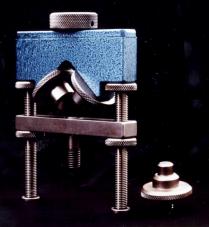
With a weight of 4kgs, the machine can be easily attached to the bar which is to be coned by means of a pair of banjo-shaped bushes (left above) or alternatively by the universal clamping blocks (right above). Either will allow coning at the bar rack.
In this case the machine is securely attached to and rotated about the bar to generate perfect cones on round, square or hexagon sections. This performance will even be achieved on poorly cropped bars.
 .
.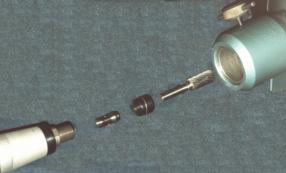
The adjustment for the depth of cut allows the operator to choose the length of cone he requires, and will be maintained on subsequent bars. The chamfer angle is fixed at 30 degrees although different angles can be made to order. The driving motor, which is of reliable and excellent construction, provides the high speed of 27,000 r.p.m. required by the cutter. Several cutters are available to cut differing types of material and can be easily replaced. Either 240 or 110 volt motors may be selected; alternatively an airline motor, running at 22,000 r.p.m. may be chosen where low power can be tolerated. A rotary joint is incorporated in the motor's cable to facilitate operation.
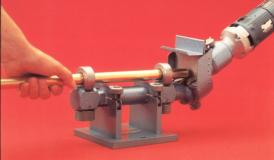
The bench attachment has been developed for small diameter sizes 5mm to 20mm where the bar is not capable of supporting the machine. The bar is brought to the work bench and threaded between the two banjo bushes or universal clamping blocks, which position the bar onto the cutter. A foot switch is available to control the motor and the bar is gently but firmly rotated by hand. Adjustment can be made for differing diameters within the size range.
The Autopointer was designed for use in our shops, where the flow of raw materials was ever increasing and a better method of preparing bright bars for bar feeding equipment was essential to keep pace with our productivity.
The former method of 'coning' the bars on the CNC equipment, considerably increased downtime and, using a centre lathe, involved additional stock movement, stacking and storage space. The portability of the Autopointer entirely eliminates this and is an outstanding feature of the design.
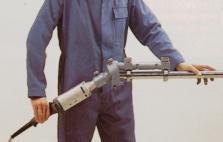
The portable machine is attached to the bar which is to be coned by means of a pair of banjo shaped bushes or alternatively by the universal clamping blocks. Either will allow coning at the bar rack (see Series 1 text above). In this case the machine is securely attached to and rotated about the bar to generate perfect cones on round, square or hexagon sections for bar diameters from 7mm to 80mm. This performance will even be achieved on poorly cropped bars.
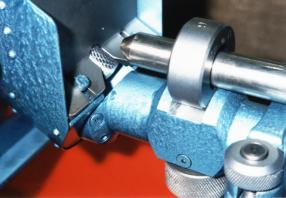
The adjustment for the depth of the cut allows the operator to choose the length of cone he requires, and will be maintained on subsequent bars. The cone angle is fixed at 30 degrees, although different angles can be made to order.
 .
.
The bench attachment has been developed for smaller diameter sizes, 5mm to 20mm, and is bolted to a suitable bench, such as the optional bench assembly, and provides a quick release cradle to carry the tool.
Either an appropriate set of banjo bushes or the universal clamping blocks can be used to support the bar in the machine. The bar is brought to the bench and is fed through each of the banjo bushes and into contact with the rotating cutter.
A foot switch is available to control the motor and the bar is gently but firmly rotated by hand. Adjustment can be made for differing diameters within the size range.
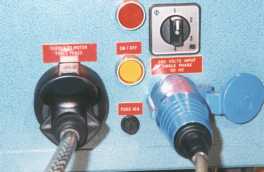
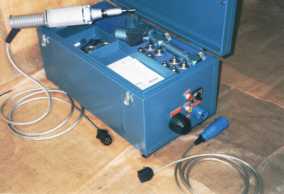

The bench assembly has been developed for those applications requiring a permanent location for coning small sizes of bar stock. The bench is assembled from a simple, but effective space frame and incorporates a transparent swarf guard, a swarf collection bin and a peg-board on which to hang the banjo bushes which are not in use.
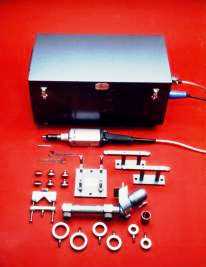
Series 2 Autopointer and accessories
| Series 1 | Series 2 | |
|---|---|---|
| Chassis | Aluminium | Aluminium / Steel | Weight, Aluminium chassis [Kgs] | 4.5 | 6.7 (900W Motor) 7.9 (1450W Motor) |
Weight, Steel chassis [Kgs] | - | 9.3 (900W Motor) 10.5 (1450W Motor) |
Length [mm] | 625 | 889 (900W Motor) 965 (1450W Motor) |
Chamfer (included) angle [degree] | 30 | Control of depth of cut [positions] | 5 | Motor connection | Clamp with sleeved grip to suit motor | Banjo/Universal clamp connection | Retained nut and spring washer | Typical maximum bar size, limited by the time to produce the cone:- | Soft materials such as Aluminium [mm dia.] | 100 | 100 | Free cutting steels [mm dia.] | 65 | 100 | Alloy and stainless steels [mm dia.] | 40 | 100 | Hi-alloy steels [mm dia.] | 25 | 100 | Minimum bar diameter [mm] | 3 | Bar sections:- | Banjo bushes | Diameter, hexagon, rectangular, square | Universal clamping blocks | Diameter | Tungsten carbide cutters | A range is available to suit the material | Utilisation | Light duty | Heavy duty | Motor usage | Non-continuous | Continuous rating | Storage | Toolbox with tray | Steerable, mobile toolbox with tray | Motors available:- | Power [W] | 500 | 900 / 1450 | Input (mains supply) [V, Ø, Hz] | 110 / 240 single phase, 50 / 60 | Invertor continuous output & current [kVA, A] | - | 2.1, 5.5 (900W Motor) 2.8, 7.4 (1450W Motor) |
Invertor frequency [Hz] | - | 400 (900W Motor, fixed speed) 300 (1450W Motor) 90 to 400 (multispeed) |
Invertor controls | - | ON / OFF illuminated pushbutton Red reset pushbutton 4 step switch (multispeed) |
Motor voltage, phase [V, Ø] | 110 / 240 single phase | 240 (fixed speed) Variable (multispeed) Three phase |
Motor speeds [r.p.m.] | 27,000 7,000 (geared) | 21,600 (900W) 5,600 (900W geared) 18,000 (1450W) |
Multispeed speed option | No | Yes, 4 speeds | Air motor | Yes, for small diameters, light cut | No | OPTIONS | Universal clamping blocks:- (for round bar only) | Adjustment | Central knob geared to threaded legs | Locking | Wavy washer and nut to each face | Inserts | 3 pairs per block | Insert range [mm] | (a)6.5 to 20; (b) 12 to 38; (c) 25 to 80 | Bench attachment:- | Attachment method | Quick release cradle with two clamping arms | Bar support | Two units to be bolted to the bench | Bench assembly:- | Type | Welded steel space frame in 5 parts |
Home page
Series 1 Autopointer
Series 2 Autopointer
Specifications